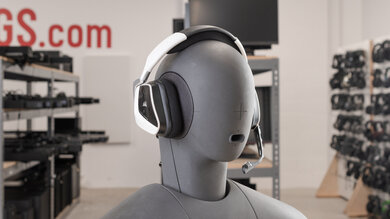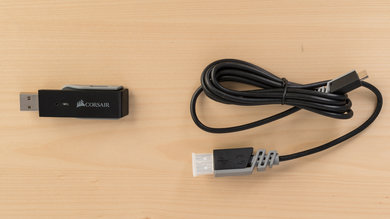Our Verdict
The Corsair Void RGB are decently well-designed gaming headphones. They have a good sound quality, they're comfortable and have very low latency which makes them suitable for critical listening, gaming and watching movies. However, they do not block a lot of noise and leak quite a bit, so they won't be the best headphones to use in public. They're also limited by their UBB transmitter which means they won't be suitable for commuting or sports.
- Comfortable.
- Good audio reproduction.
- Good microphone that filters out noise.
- Bulky design not meant for outdoors.
- Poor noise isolation.
- Leaky at high volumes.
Great for neutral listening. They have a comfortable design, a well-balanced frequency response with a good amount of bass and fair representation of instruments and vocals. They also have a decently spacious soundstage and a good stereo image reproduction which is suitable for both neutral listening and gaming.
Below-average for commuting. The Corsair Void RGB have to be in range of the USB transmitter so they won't be suitable for commuting or traveling, unless you're on a plane or train and using a laptop. Unfortunately, they also do not block a lot of noise so they won't be the best headphones to use on a train either.
Subpar for sports. They have a bulky design that's not stable enough for running or working out. They're also limited by their transmitter so unless your working out indoors they won't be very practical.
Average for office use. They have a comfortable and easy-to-use design you can wear for hours. Unfortunately, the Corsair Void RGB leak quite a bit at higher volumes and won't block the ambient chatter of a noisy office environment.
Good for gaming. The Corsair Void have low latency, an easy-to-use and comfortable wireless design, and a good noise filtering mic. They won't be the best headphones if you have a particularly noisy gaming environment like being at a competition. However, they deliver a decent battery life with power saving features, a good wireless range and a good sound for both gaming and listening to music. They also come with an above-average software that provides a convenient parametric equalizer but feels a bit lacking compared to other gaming headsets.
Changelog
- Updated Mar 07, 2022: Retested the companion app's compatibility with macOS.
- Updated Mar 24, 2020: Converted to Test Bench 1.4.
- Updated Nov 21, 2019: Converted to Test Bench 1.3.1.
- Updated Nov 21, 2019: Converted to Test Bench 1.3.
Check Price
Popular Headphones Comparisons
The Corsair HS80 RGB WIRELESS are somewhat better for wireless gaming than the Corsair Void PRO RGB Wireless. Their boom mic has a much better recording quality, and they have a somewhat longer continuous battery life. They're also significantly better-built, and you can also use them wired with PCs via USB, while you can't use the Void with a wired connection at all. On the other hand, the Void's boom mic has a much better noise handling performance. They also have lower non-Bluetooth latency.
The Corsair Void PRO RGB Wireless are better gaming headphones than the Astro A10 Gen 2. While both headphones are comfortable, the Corsair are wireless gaming headphones with low wireless latency, and they support Dolby 7.1, which is a virtual soundstage feature that can create a more immersive sound. They also have companion software that offers a graphic EQ and presets so you can customize their sound to your liking, and their boom mic offers a better noise handling performance. However, if you prefer wired gaming headphones, the Astro are better built and have a more neutral sound profile that some users may prefer, and their mic has a better recording quality.
The HyperX Cloud 2/Cloud II is an overall better gaming headset than the Corsair Void PRO RGB Wireless if you don't need a wireless headset. They are more comfortable and are better built than the Corsair. The HyperX also has a better microphone for online gaming. On the other hand, the Corsair has slightly better audio reproduction, especially with sharp noises in the treble range. Unfortunately, they can't be used wired and have a relatively short battery life, which is something you won't have to worry about with the wired HyperX. However, you'll be able to customize their sound with the in-app EQ, which HyperX doesn't have.
The Corsair Void PRO RGB Wireless and the HyperX Cloud Stinger are both decent gaming headphones, but the Corsair have a wireless connection while the HyperX are wired-only. Other than that, both are equally comfortable and feel decent durable, but the Corsair have a slightly better-balanced sound profile that's more consistent among various users and reseats. They also have companion software that gives you access to EQ settings, while the HyperX has no software. On the other hand, the HyperX's microphone performs much better overall, and their wired connection gives them no lag or latency issues.
Test Results
The Corsair Void Pro are an unusual looking pair of gaming headphones. They have a futuristic vibe with square-ish ear cups and a wide flexible headband. They look and feel like gaming headsets, and since the mic is not removable or even retractable, they will not pass for casual headphones. On the upside, the unique design will work for some, and their two-tone or all-black matte color schemes look a bit more professional than some of the other gaming headsets we've reviewed.
The Corsair Void RGB are well-padded headphones with a decently comfortable fit. The ear cups are large and spacious, and the headband isn't too tight, so they won't clamp your head like some of the other gaming headphones we've tested. However, they are somewhat heavy, and the shape of the ear cups may not be ideal for all listeners.
Update 11/09/2019: We previously had 'Channel Mixing' set to N/A instead of No, which was making the score of the Void RGB higher than what it was supposed to be. The review has been updated.
The Corsair Void Pro RGB have a decent gaming-centric control scheme. They have a mic on/off button and a toggle dial to control the volume. The dial is especially responsive and easy-to-use, but the placement of the power and microphone buttons takes a bit more time to get used to.
The Corsair Void RGB are not portable. Like most gaming headsets, they do not fold into a more compact form factor. The ear cups lay flat but still take up quite a bit of space. They're also limited by the range of their USB transmitter which makes them a bit less portable since you have to carry the USB stick around too.
The Corsair Void Pro are well-made headphones with a super flexible headband, but they just don't feel as sturdy as some of the other gaming headsets we've reviewed. The headband and hinges have a metal frame that makes their design somewhat durable. They also make use of a lot of premium materials in their build quality and padding. Unfortunately, the Void RGB's hinges are very loose out of the box. The exposed boom mic is susceptible and will break if tilted too far, and the ear cups have a glossy back plate that will get scratched by regular wear and tear. overall the void should be a fairly sturdy headset for most but will not be as durable as the Corsair HS70 Wireless or the Virtuoso RGB Wireless.
These headphones are not stable enough for anything but casual listening and gaming. They're bulky and have a slightly loose fit, which makes them sway a lot under any strenuous conditions. They're not designed to stay on your head if you use them while running, jogging or working out, but they should be fine for gaming on your couch or listening to music while walking around in your home. They're also wireless, so you will have no cable management issues.
Good consistency performance. In the bass range, the Void RGB performs very consistently across our human subjects and doesn't seem to be affected by wearing glasses either. They perform less consistently in the treble range, presumably due to the ear cup design, but still within decent limits.
Good bass range performance. LFE is extended down to 33Hz, which is good. Low-bass, which is responsible for thump and rumble, however, is lacking by about 3dB. Bass has a wide 5dB bump centered around 80Hz and continuing up to 150Hz, adding a bit of excess kick which some may like.
Good mid range performance for the Corsair Void RGB. Low-mid and mid are quite flat and consistent. The 5dB bump around 1KHz, adds to the intensity and projection of vocals/leads.
Very good treble range performance. Low-treble is relatively flat but underemphasized by 2dB. This decreases the presence and detail of vocals/leads. However, the peak around 7KHz makes the S and T sounds, a bit sharp and piercing on overly bright tracks.
Poor isolation. These headsets do not isolate below 1KHz, and above that achieve only 16dB of isolation, which is sub-par.
Sub-par leakage performance. The significant portion of leakage sits between 400Hz and 7KHz, which is a broad range. The overall level of leakage is also relatively loud.
With LFE at 546Hz, the 5dB dip below 500Hz, and HFE at 6.5KHz, speech recorded with the Void RGB will sound noticeably thin, slightly airless and muffled.
Very good noise handling performance. The Corsair Void RGB achieves a speech-to-noise ratio of 35dB, making them suitable for almost all environments.
The battery life of the Corsair Void is good but could be better. They last about 12 Hours on a single charge which is suitable for most gaming sessions. You can also charge them while playing if you're close to a power source, which is ideal if you're having a gaming marathon. However, they take about 3 hours to charge, which is a little on the longer side and there's no passive playback with a USB cable.
Update 03/07/2022: The results originally indicated that the Corsair iCue app is not compatible with macOS. Ηowever, the software has been compatible with macOS and Windows since a 2019 firmware update. The results have been updated with the correct information.
The Corsair Utility Engine provides a decent amount of options but feels a little lacking. It gives you access to a good graphic EQ. You can also control the microphone's volume and the color and display speed of the built-in headphone lights. Unfortunately, the software lacks a few features like button mapping surround sound calibration and noise gate options for the mic, which makes it feel a bit less useful.
These headphones have a great latency performance for gaming and watching movies. You will rarely notice any lag or latency between audio and visual data.




























































































